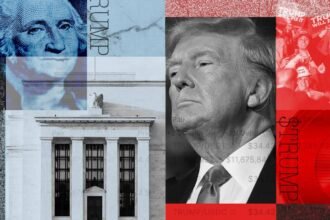Swamp Notes readers will know that I’ve been convinced for some time that we are headed towards a political economy pendulum shift. The last time we had one of these was during the Reagan-Thatcher era, when deregulation and globalisation released animal spirits, and US assets in particular began a tremendous bull run. These sorts of pendulum shifts happen every 50 years or so, and I think we may look back at the last week or so and remember it as a critical moment in the shift to a new world order.
Why do I say this? For starters, gold hit a record high last week — and again this morning. Part of this is about investors looking for an inflation hedge as US job markets continue to be incredibly robust. But another part of it is about a broader, more nebulous feeling that we are entering a post-Bretton Woods era in which investors will need to hedge against dollar assets as the Washington Consensus gives way to a more multipolar world.

Currency Research Associates, an investment research group that I follow closely, proclaimed as much in a report last Friday, saying that it believed gold was now on a proper bull run that would last for several years as dollar assets corrected and other global currencies, including the yen and the euro, gained steam. The report noted that the way in which China was buying gold and selling Treasuries reflected the shift in global currency regimes in the decades leading up to the 1980s. This won’t favour dollar assets.
I always feel pretty confident about my world view, but I feel much less confident about my market timing. I wrote my first piece about the rise of gold as a sign of a post-dollar world back in 2019. I continued writing about the trend after Covid-19, and following the war in Ukraine, which marked a pivot towards a more multipolar world as the weaponisation of the dollar caused emerging markets to rethink their reserve allocations. I’ve been writing about the rise of a post-neoliberal world for several years as well. This may be the moment we remember as a historic turning point towards that new world.
Consider, for example, US Treasury secretary Janet Yellen’s recent trip to China, to complain about green tech dumping, among other things. China has taken a very hard line here and looks unlikely to shift its tactics despite concern from both the US and the EU. As economist Michael Pettis has written, when everyone subsidises manufacturing all at once, trade wars and currency wars ensue.
Another Trump presidency would put this on steroids. Former US Trade Representative Robert Lighthizer has been held up as a possibility for the Treasury secretary position in a second Trump administration, and I know for a fact that he would push for a weaker dollar policy because it’s good for US exports, rather than for financial assets. This would track with President Joe Biden’s own re-industrialisation strategy, which will ultimately require a weaker dollar if it’s to succeed.
In some ways, you could argue that this would be a good thing. After all, the Business Roundtable itself was more concerned about the export economy than the financial one up until the 1990s, when trade deregulation exacerbated a trend towards outsourcing and financialisation. Americans started to make less, and leverage more. That came with risks, as we now know, as well as massive rewards for the owners of capital. We are due for a pendulum shift, and I suspect strongly that the not-so-secret message in gold right now is — it’s coming.
Peter, would you agree? And if so, what might the economic and political fallout be?
Recommended reading
Peter Spiegel responds
Rana Foroohar: Gold Bug! Who knew?
In all seriousness, I’m far less confident in my economic worldview than you are in yours, Rana, so all I can do is look at the data and draw the conclusions I see in front of me. And I’m just not convinced the recent rally in gold is a sign of anything other than renewed fears that inflation is not disappearing as quickly as many (including Jay Powell) had hoped.
As staff in the FT’s New York newsroom will no doubt tell you, I made a bit of a prediction myself last month that the Fed would not cut rates at all this year. Neel Kashkari became the first Fed policymaker to agree with me last week (though I suspect that my newsroom rants weren’t all that influential on his thinking).
The fact of the matter is that since the start of the year, the US economy has grown robustly, the rate of inflation appears to have stopped falling, and the job market remains tight. Powell appears to be ignoring those signs, but I’m not — and I think the move in gold is just the commodity market coming to the same conclusions I have.
The macroeconomic trends you’re seeing certainly do exist: the US economy is ever more leveraged, with sovereign debt levels remaining near their Covid-era high — and no signs of them coming down. After a brief pause thanks to pandemic stimulus payments, US household debt also continues its precipitous rise.
But do you really think that the euro or the renminbi is going to replace the dollar as the world’s reserve currency? Or that the sovereign debt of any other G20 country is going to replace Treasuries as the international benchmark? For all the macroeconomic warning signs you cite, the US economy remains the biggest in the developed world and its legal system is transparent, (relatively) quick and (mostly) free of political influence. That’s why dollar-backed assets are so attractive.
To paraphrase Winston Churchill, the US may be the worst form of economies — except for all the other ones.
Your feedback
We’d love to hear from you. You can email the team on swampnotes@ft.com, contact Peter on peter.spiegel@ft.com and Rana on rana.foroohar@ft.com, and follow them on X at @RanaForoohar and @SpiegelPeter. We may feature an excerpt of your response in the next newsletter
Recommended newsletters for you
Unhedged — Robert Armstrong dissects the most important market trends and discusses how Wall Street’s best minds respond to them. Sign up here
The Lex Newsletter — Lex is the FT’s incisive daily column on investment. Local and global trends from expert writers in four great financial centres. Sign up here




















